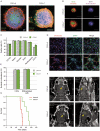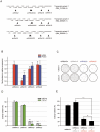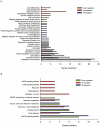An off-target nucleostemin RNAi inhibits growth in human glioblastoma-derived cancer stem cells
- PMID: 22174890
- PMCID: PMC3236221
- DOI: 10.1371/journal.pone.0028753
An off-target nucleostemin RNAi inhibits growth in human glioblastoma-derived cancer stem cells
Abstract
Glioblastomas (GBM) may contain a variable proportion of active cancer stem cells (CSCs) capable of self-renewal, of aggregating into CD133(+) neurospheres, and to develop intracranial tumors that phenocopy the original ones. We hypothesized that nucleostemin may contribute to cancer stem cell biology as these cells share characteristics with normal stem cells. Here we report that nucleostemin is expressed in GBM-CSCs isolated from patient samples, and that its expression, conversely to what it has been described for ordinary stem cells, does not disappear when cells are differentiated. The significance of nucleostemin expression in CSCs was addressed by targeting the corresponding mRNA using lentivirally transduced short hairpin RNA (shRNA). In doing so, we found an off-target nucleostemin RNAi (shRNA22) that abolishes proliferation and induces apoptosis in GBM-CSCs. Furthermore, in the presence of shRNA22, GBM-CSCs failed to form neurospheres in vitro or grow on soft agar. When these cells are xenotransplanted into the brains of nude rats, tumor development is significantly delayed. Attempts were made to identify the primary target/s of shRNA22, suggesting a transcription factor involved in one of the MAP-kinases signaling-pathways or multiple targets. The use of this shRNA may contribute to develop new therapeutic approaches for this incurable type of brain tumor.
Conflict of interest statement
Figures







Similar articles
-
BMI1 sustains human glioblastoma multiforme stem cell renewal.J Neurosci. 2009 Jul 15;29(28):8884-96. doi: 10.1523/JNEUROSCI.0968-09.2009. J Neurosci. 2009. PMID: 19605626 Free PMC article.
-
Biologic characteristics of the side population of human small cell lung cancer cell line H446.Chin J Cancer. 2010 Mar;29(3):254-60. doi: 10.5732/cjc.009.10330. Chin J Cancer. 2010. PMID: 20193106
-
Identification of cancer stem cells from human glioblastomas: growth and differentiation capabilities and CD133/prominin-1 expression.Cell Biol Int. 2012 Jan;36(1):29-38. doi: 10.1042/CBI20110013. Cell Biol Int. 2012. PMID: 21916848
-
CD133 as a marker for regulation and potential for targeted therapies in glioblastoma multiforme.Neurosurg Clin N Am. 2012 Jul;23(3):391-405. doi: 10.1016/j.nec.2012.04.011. Epub 2012 Jun 5. Neurosurg Clin N Am. 2012. PMID: 22748652 Review.
-
Glioblastoma cancer stem cells--from concept to clinical application.Cancer Lett. 2013 Sep 10;338(1):32-40. doi: 10.1016/j.canlet.2012.05.033. Epub 2012 Jun 2. Cancer Lett. 2013. PMID: 22668828 Review.
Cited by
-
Efficacy of rapamycin against glioblastoma cancer stem cells.Clin Transl Oncol. 2014 May;16(5):495-502. doi: 10.1007/s12094-013-1109-y. Epub 2013 Sep 17. Clin Transl Oncol. 2014. PMID: 24043497
-
Subtyping glioblastoma by combining miRNA and mRNA expression data using compressed sensing-based approach.EURASIP J Bioinform Syst Biol. 2013 Jan 14;2013(1):2. doi: 10.1186/1687-4153-2013-2. EURASIP J Bioinform Syst Biol. 2013. PMID: 23311594 Free PMC article.
-
Ribogenesis boosts controlled by HEATR1-MYC interplay promote transition into brain tumour growth.EMBO Rep. 2024 Jan;25(1):168-197. doi: 10.1038/s44319-023-00017-1. Epub 2024 Jan 15. EMBO Rep. 2024. PMID: 38225354 Free PMC article.
-
Specificity of oligonucleotide gene therapy (OGT) agents.Theranostics. 2022 Oct 9;12(16):7132-7157. doi: 10.7150/thno.77830. eCollection 2022. Theranostics. 2022. PMID: 36276652 Free PMC article. Review.
-
Enhancement of radiosensitivity by the novel anticancer quinolone derivative vosaroxin in preclinical glioblastoma models.Oncotarget. 2017 May 2;8(18):29865-29886. doi: 10.18632/oncotarget.16168. Oncotarget. 2017. PMID: 28415741 Free PMC article.
References
-
- Maher EA, Furnari FB, Bachoo RM, Rowitch DH, Louis DN, et al. Malignant glioma: genetics and biology of a grave matter. Genes Dev. 2001;15:1311–1333. - PubMed
-
- Stupp R, Mason WP, van den Bent MJ, Weller M, Fisher B, et al. Radiotherapy plus concomitant and adjuvant temozolomide for glioblastoma. N Engl J Med. 2005;352:987–996. - PubMed
-
- Clarke MF, Dick JE, Dirks PB, Eaves CJ, Jamieson CH, et al. Cancer stem cells–perspectives on current status and future directions: AACR Workshop on cancer stem cells. Cancer Res. 2006;66:9339–9344. - PubMed
-
- Lapidot T, Sirard C, Vormoor J, Murdoch B, Hoang T, et al. A cell initiating human acute myeloid leukaemia after transplantation into SCID mice. Nature. 1994;367:645–648. - PubMed

